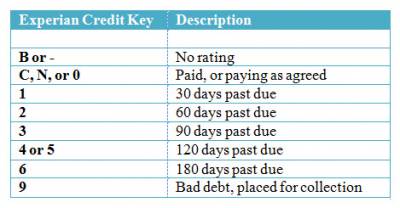Here are the most important factors to pay attention to on a credit report:
- The credit score/credit score factors. what is a good credit score.
The score reflects all aspects of the report that indicate whether or not the consumer is likely to pay their bills on time. Higher the better, avg score for renters is about 625. Credit score factors point out key aspects of the report that brought the score down. Every report will have at least 4 factors.
- The payment history. The payment history is found in the far right column of each section. The history will show if the consumer has been current with their payments (shown with the letter "C") or how many months late their payment was( "1, 2, 3, 4, etc"), or if the account is derogatory or in collections, reported as a "9." C's are good, numbers in the payment history indicate the payments were late or are now in collection status.
READING A CREDIT REPORT SECTION BY SECTION
READING A CREDIT REPORT CAN BE CONFUSING, SO LET'S START FROM THE TOP:
1. The Heading is at the very top right of the report. It contains the Credit
Bureau's information. The Credit Agency, their address, their phone number, and
the date the report was inquired upon.
PERSONAL INFORMATION
2. The next section of the report is the applicant's personal information. This
includes the Consumer's name, social security number, up to three different
addresses, date of birth (if available), and telephone number (if available).
TIP: Check the addresses against those submitted in the rental application. Do they
match? The addresses are located below the applicants Name with the most current
address directly below the applicants name and chronologically listed from there. The
employment and birth date information are located to the right of the applicant's
addresses and above the summary score. Former addresses and employment
information is inputted when a consumer applies for credit. Therefore it can or cannot be
a definitive verification of the last three residences or jobs.
EMPLOYMENT INFORMATION
3. This section of the report is the applicant's employment information. This
includes the company name, date hired (if available), income (if available),
occupation (if available), and separation date (if available).
TIP: Check the employment history against those submitted in the rental application Do
they match? The employment history may not necessary have the most current
information. Former addresses and employment information is inputted when a
consumer applies for credit. Therefore it can or cannot be a definitive verification of the
last three residences or jobs. . ALWAYS LOOK UP THE EMPLOYER PHONE NUMBER
YOURSELF
REPORT SUMMARY
4. Here is the overall summary of the applicant's credit history. This will tell you
the total number of accounts the applicant has, accounts that are still currently
active or negative or too new to be rated, accounts that are past due or paid off,
person(s) that have inquired upon the applicant's credit history, accounts that are
in collections or public records, total amount still owed, and a breakdown of the
amount.
SCORECARDS
5. The score summary, Experian/FICO, is above the applicants credit and trade
information and is the overall rating of the applicant's credit. Up to four factors are
disclosed and are displayed in order based on their relative impact on the final
score. Generally scores exceeding 625 are considered by banks as worthy of
loans. The lowest scores are in the low 400's and the highest scores close to 850
(Very few). Scores between 600 and 700 are very common and considered very
good. Most tenant applicants will fall between 550 and 650 credit scores. Scores
below 575 are considered a risk, and usually warrant further documentation or
higher security deposits if the landlord proceeds. (Note: No Hit means that the
consumer has no credit history whatsoever and nobody has even inquired upon
their credit history)
Number of accounts delinquent
Proportion of balance to high credit on bank revolving or all revolving accounts
Length of time (or unknown time) since account delinquent
COLLECTIONS
6. Identifies consumer accounts that have been transferred to a professional
debt-collecting firm. Collection information includes the name of the collection
agency providing the information, collector's kind-of-business designators, and
the consumer's account number with the collection agency. Also included is the
date the amount was charged off by the original creditor, date the information
was verified, the original dollar amount of collection, the balance owed as of date
verified or closed, name of the original creditor, and an explanation of current
account status as reported by the collection agency.
PUBLIC RECORDS
7. Public Records
information consists of bankruptcies against a consumer.
This information will include original
filing date with court,discharge status and status date,
liability and asset amounts
TRADELINES
8. Under the trade lines portion of the credit report, creditors report the amount of
loans and credit cards with payment histories. The name of the creditor is in the
left column, the credit amount information in the center column, and the payment
history is in the right column.
PAYMENT HISTORY
9. On the far right hand side of the report is the consumer payment history for
the past 24 months. These codes reflect the monthly status of an account and
are displayed for balance reporting loans. Collections and charge-offs are not
graded. These codes stand for:

INQUIRIES
10. This portion of the report is named inquiries. This is a list of companies that
have inquired about the applicant's credit, usually for the purpose of extending
new or additional credit. Numerous inquiries lower the applicant's summary score
by about two points per inquiry.
WARNINGS/MESSAGES
11. The last portion of the report is for warning messages. This is a list of
messages that are about the applicant's credit, social security number,
name, and/or address.